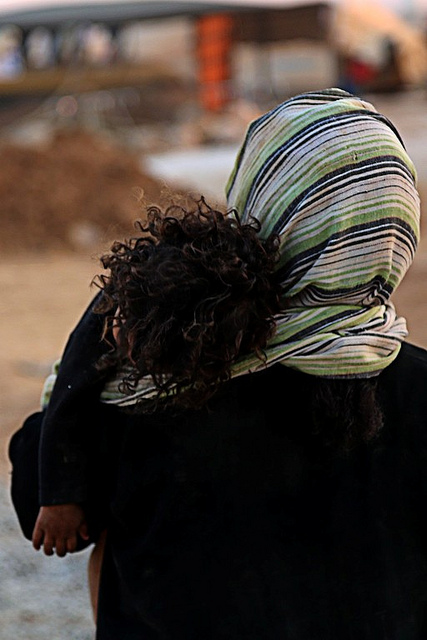Emotional Health – Surviving the Maelstrom
/Julie Rowley, Contributing AuthorLast Modified: 00:10 a.m. EDT, 15 August 2013

Being healthy is about more than just keeping physically fit and maintaining a good work/life ratio. With all that life throws at us: the small troubles we encounter and have to resolve each day; the monumental tribulations that arrive on our doorsteps unannounced; and the vagaries of our bodies, we ride an emotional roller-coaster that can take its toll on us.
Our Bodies
From the time we hit our menses, we are subject to the ever fluctuating chemical balance of our bodies. We may experience anxiety about our menstruation, both anticipating it and dreading its arrival. For some women their monthly cycle is a time of intense pain, with cramps which can affect not just the abdomen, but circle around to the back as well.
For women with heavy menstrual flow there is the additional concern throughout this time of keeping clean and the fear that the telltale signs will appear on our clothing. Another common fear that women face is the absence of their menses, which may indicate an unwanted pregnancy. With the best will in the world and the use of birth control, slips can sometimes occur. At the other end of this scale are the women for whom the appearance of their menses means the conception they are trying to attain has not happened – yet again.
This comes with the corresponding disappointment and when this becomes a long term occurrence, depression and anxiety, as well as feelings of failure can set in.
Pregnancy is for most women a strange mixture of joy and misery: from the morning sickness (who ever coined that phrase has a lot to answer for…), through the dizzy spells; water retention; and cravings for foods we would normally not look at once, let alone twice; to the discomfort of the baby taking up so much room that all our normal body functions are disrupted. This is seasoned liberally with the awe and wonder of this little being growing inside us; the swelling abdomen; the first noticeable flutter of movement and we become completely and compellingly absorbed in this process.
Our hormones are wildly out of control during this time and although usually rational and reasonable people, we become emotional and volatile. Things which normally we would shrug off hurt or anger us instead. Some women find that their desire for a normal, intimate relationship with their partner dwindles or vanishes altogether during their pregnancy. This can be frustrating for the partner and a source of concern that the relationship is not as close as it was beforehand.
The diminution or complete loss of desire during pregnancy may come as a surprise, but in actual fact it is quite common and a normal feature of pregnancy. Nonetheless it can cause tension and stress between partners. Added to this already complex bundle of changing needs and emotions is the ongoing concern about the baby: the fear of miscarriage during the first 16 weeks; the waiting for the first movement and worrying if it does not happen at what we are told is the “right time”, even though it varies from one pregnancy to another; then dealing with all the odd twinges and aches which occur through the later part of pregnancy.
The birth itself can be a source of anxiety and fear, particularly if it is the first; and this is mingled with a sense of anticipation and excitement that the moment has finally arrived and very soon the “bump” will be gone and we will be able to hold our son or daughter.
Published: 15 August 2013 (Page 2 of 2)
Further along the line, when we reach the end of our childbearing years, we have the looming specter of menopause. Not only do we have to deal with the regrets and feelings of loss as we leave behind the prospect of fertility and release our past identity to embrace the new phase we are entering, which in itself can be difficult and prolonged; but we have to deal with any physical symptoms which can accompany menopause.
Some women are lucky enough to sail through, while at the other end of the spectrum are those who experience every unpleasant physical side effect in the book, having to deal with the embarrassment of: sweats; mood swings; sleeping problems; and palpitations; to name but a few. We may have to deal with depression, anxiety and feelings of loss of identity or alienation as we struggle to find new meaning to our lives.

Dealing with the Emotional Fallout
The emotional and mental experiences of these phases of our lives would be enough by themselves to live through and come out the other side in one piece. However, this is only, as women know only too well, a small part of the picture. We can add to this the many milestones and events, both large and small, in our life which can cause stress, anxiety and depression; the negatives can often seem to outweigh the positive, especially when we are dealing with bereavement and loss.
We now recognize that grief follows a natural cycle, whether that grief is related to losing a job or perhaps a divorce; anything which takes something out of our lives will trigger the grief cycle. This is composed of around 5 different stages, although there are different interpretations and some include 7 stages.
The first stage is of shock and denial, when it is difficult to grasp or to accept what has happened. As the reality of our loss becomes more real, the initial shock can turn to anger, which can be directed inwards at us or outwards at the world.
Following this we may enter a stage of trying to change the situation by altering our position in relation to it, by bargaining for the return of what or who we have lost.This passes and we then enter a phase of deep sorrow and depression, where life can lose its meaning for us and everything becomes a struggle. Finally we reach a level of acceptance of what has happened and our lives start to move forward again. It can take several years on average to work through this process, although everyone re-adjusts at their own pace and may take longer to pass through some stages than others.
Occasionally our own internal emotional processes become unable to complete the grief cycle and we can become stuck in one of the stages. At times like this, where our own resources and inner strength are not enough to find resolution to our problems, we depend on those close to us to understand and be there for us.
Sometimes though they are unable to give us the help we need to move on through the grieving process and it is at times like this where counseling can be invaluable; to be able to release our thoughts and emotions around our loss to someone who can understand and empathize, as well as helping us to see things from a different perspective and facilitate our moving forward once more.
When we think of the toll that a lifetime of such emotions can take on us, it is truly amazing that not only do we manage to survive this wild ride, but is a tribute to women everywhere that we emerge as such profound and inspiring human beings.
Follow Julie Rowley on Twitter Twitter: @nahmias_report
Related articles
Ain't No Sunshine (itsmycrazyblog.wordpress.com)
Week 1 of pregnancy: The planning week (healthfore.wordpress.com)
How to Help a Grieving Person (littleblogoflettinggo.com)
waiting thoughts (dellaquella.wordpress.com)
Woman works through grief by creating jewelry, connections between others (billingsgazette.com)
Coping with Grief & Loss: Understanding the Grieving Process (lilbitodisndat.wordpress.com)




























































